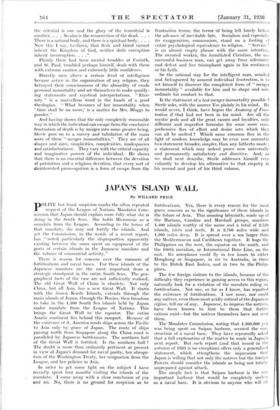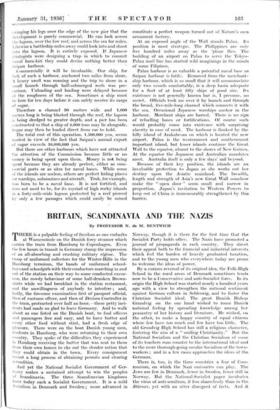JAPAN'S ISLAND WALL
By WILLARD PRICE
POLITE but frank suspicion marks the often repeated request of the League of Nations Mandates Com- mission that Japan should explain more fully what she is doing in the South Seas. She holds Micronesia as a mandate from the League. According to the terms of that mandate, she may not fortify the islands. And yet the Commission, in the words of a recent report, has " noted particularly the disproportion apparently existing between the sums spent on equipment of the ports of certain islands in the Japanese mandate and the volume of commercial activity."
There is reason for concern over the rumours of fortifications and naval bases. For these islands of the Japanese mandate are the most important from a strategic standpoint in the entire South Seas. The geo- graphical facts of the ease are not sufficiently realised. The old Great Wall of China is obsolete. Not only China, but all Asia, has a new Great Wall. It starts with the frozen Kurile Islands, extends through the main islands of Japan, through the Hollins, then broadens to take in the 1,400 South Sea islands held by Japan under mandate from the League of Nations. This brings the Great Wall to the equator. The entire Asiatic continent lies behind this rampart. Because of the existence of it, America sends ships across the Pacific to Asia only by grace of Japan. The route of ships passing north from Singapore along the China coast is paralleled by Japanese battlements. The northern half of the Great Wall is fortified. Is the southern half ? The doubt is more than ordinarily pertinent at present in view of Japan's demand for naval parity, her abroga- tion of the Washington Treaty, her resignation from the League, and her policies in Asia.
In order to get some light on the subject I have recently spent four months visiting the islands of the mandate. I come away with a clear conclusion of yes and no. No, there is no ground for suspicion as to fortifications. Yes, there is every reason for the most grave concern as to the significance of these islands in the future of Asia. This amazing labyrinth, made up of the Mariana, Caroline and Marshall groups, numbers 1,400 islands worthy of the name and a total of 2,550 islands, islets and reefs. It is 2,700 miles wide and 1,300 miles deep. It is spread over a sea larger thin the Mediterranean and Caribbean together. It hugs the Philippines on the west, the equator on the south, and the 180th meridian, or International Date Line, on the east. Its aeroplanes could fly in ten hours to either Hongkong or Singapore, in six to Australia, in three to the Dutch East Indies, and in two to the Philip- pines. .
The few foreign visitors to the islands, because of the difficulty they experience in gaining access to thiS region, naturally look for a violation of the mandate ruling on fortifications. Not one, so far as I know, has reported the existence of fortifications. I saw none, nor could any natives, even those most acidly critical of the Japanese regime, tell me of any. Japanese, to impress the natives, have been known to hint to them that 'fortifi- cations exist—but the natives themselves have not seen them.
The Mandates Commission, noting that 1,500,000 yen was being spent on Saipan harbour, scented the con- struction of a naval base. They have repeatedly asked that a full explanation of the matter be made in Japan's next report. But each report (and that issued in the autumn of 1935 is no exception) offers only a generalised statement, which strengthens the impression• that Japan is willing that not only the natives but the foreign Powers should consider the islands as being not totally unprepared against attack.
The simple fact is that Saipan harbour is the one important harbour that would be completely useless as a naval base. It is obvious to anyone who will sit .winging his legs over the edge Of the new pier that the development is purely commercial • He can look across t he lagoon, over the low reef, and across the sea for Miles. likewigea battleShip miles away could loot: into and shoot into the lagoon. It is entirely exposed: If Japanese strategists were designing • a trap in which to–commit naval hara-kiri they could devise nothing better 'than Saipan harbour. ' * ' Commercially it will be invaluable. Our ship, for lack of such 'a harbour, anchored two miles from shore. A heavy 'swell was running and the trip to shore in a small launch through half-subinerged- reefs Was pre rarious:' Unloading and loading were delayed' because of the roughness of the sea: Sometimes a ship must lie here for ten days before it can safely receive its cargo of sugar.
Therefore a channel 90' metres wide and 1,600 metres long is being blasted through the reef, the lagoon is being dredged' to greater depth; and a pier has been constructed so that a ship of 4,000 tons may lie alongside. Sugar may then be loaded direct from car to hold.
The total cost of this operation, 1,500,000 yen, seems modest in view of the fact that Saipan's annual export of sugar exceeds 10,000,000 yen.
But there are other harbours which have not attracted the attention of the Commission 'because little or no money is being spent upon them. Money is not being spent because they are already perfect, either as com- mercial ports or as sites for naval bases. While some of the islands are useless, others are perfect hiding places for warships, submarines and aircraft. Truk, for example, was born to be a naval base. It is not fortified, and does not need to be, for its myriad of high rocky islands in a forty-mile-wide lagoon protected by a reef pierced by only a few passages which could easily be mined constitute a perfect weapon turned out of Nature's own armament factory.
At an exposed angle 'of the Wall stands Palau. Its Position is most strategic. The Philippines are only five hundred miles away as the 'plane flies. The building of an airport on Palau to serve the Tokyo- Palau mail line has started' wild imaginings in the minds of some Filipinos.
Palau harbour is as valuable a potential naval' base as Saipan harbour is futile. Removed from the merchant- ship harbour, which is so small that it will accommodate only two vessels comfortably, is' a deep basin adequate for a fleet of at least fifty ships of good size. Its existence is not generally known but is, I presume, no secret. Officials took me over it by launch and through the broad, five-mile-long channel which 'connects it with the sea. Occasional Japanese warships anchor in the harbour. Merchant ships are barred. There is no' sigh of 'refuelling 'bases or fortifications. Of course such would probably -come into existence- with surprising alacrity in case of need. The harbour is flanked by the hilly island of Arakabesan on which is located the new airport. Palau is the westernmost and southernmost important island, but lesser islands continue the Great Wall to the equator, almost to the shores of New Guinea. At the equator the Japanese and Australian mandates meet. Australia itself is only a few days' sail beyond.
Because of their key position, the islands are an invaluable protection to Japan as she works out her destiny upon the Asiatic mainland. The breadth, length and strength of Asia's new Great Wall somehow make the " open door " seem small and narrow in proportion. Japan's invitation to Western Powers to keep out of China is immeasurably strengthened by this barrier.











































 Previous page
Previous page